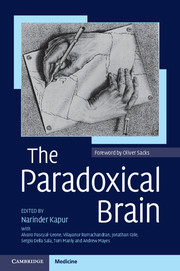Book contents
- Frontmatter
- Contents
- Acknowledgements
- Preface
- Foreword
- Author affiliations
- Abbreviations
- 1 The paradoxical nature of nature
- 2 Paradoxical effects of sensory loss
- 3 Paradoxical functional facilitation and recovery in neurological and psychiatric conditions
- 4 Paradoxes in neurorehabilitation
- 5 The paradoxical self
- 6 Paradoxical psychological functioning in early child development
- 7 Cognitive ageing: a positive perspective
- 8 Paradoxes of learning and memory
- 9 The paradox of human expertise: why experts get it wrong
- 10 Paradoxes in Parkinson's disease and other movement disorders
- 11 Paradoxical phenomena in epilepsy
- 12 Paradoxical creativity and adjustment in neurological conditions
- 13 Paradoxical functional facilitation with noninvasive brain stimulation
- 14 Unexpected benefits of allergies and cigarette smoking: two examples of paradox in neuroepidemiology
- 15 The paradox of autism: why does disability sometimes give rise to talent?
- 16 Paradoxes in creativity and psychiatric conditions
- 17 The paradox of psychosurgery to treat mental disorders
- 18 The paradox of electroconvulsive therapy
- 19 Paradoxes of comparative cognition
- 20 Paradoxical phenomena in brain plasticity
- 21 Immature neurons in the adult brain. Breaking all the rules
- 22 The paradoxical hippocampus: when forgetting helps learning
- 23 Paradoxical effects of drugs on cognitive function: the neuropsychopharmacology of the dopamine and other neurotransmitter systems
- 24 The paradoxical brain – so what?
- Index
- References
2 - Paradoxical effects of sensory loss
Published online by Cambridge University Press: 05 December 2011
- Frontmatter
- Contents
- Acknowledgements
- Preface
- Foreword
- Author affiliations
- Abbreviations
- 1 The paradoxical nature of nature
- 2 Paradoxical effects of sensory loss
- 3 Paradoxical functional facilitation and recovery in neurological and psychiatric conditions
- 4 Paradoxes in neurorehabilitation
- 5 The paradoxical self
- 6 Paradoxical psychological functioning in early child development
- 7 Cognitive ageing: a positive perspective
- 8 Paradoxes of learning and memory
- 9 The paradox of human expertise: why experts get it wrong
- 10 Paradoxes in Parkinson's disease and other movement disorders
- 11 Paradoxical phenomena in epilepsy
- 12 Paradoxical creativity and adjustment in neurological conditions
- 13 Paradoxical functional facilitation with noninvasive brain stimulation
- 14 Unexpected benefits of allergies and cigarette smoking: two examples of paradox in neuroepidemiology
- 15 The paradox of autism: why does disability sometimes give rise to talent?
- 16 Paradoxes in creativity and psychiatric conditions
- 17 The paradox of psychosurgery to treat mental disorders
- 18 The paradox of electroconvulsive therapy
- 19 Paradoxes of comparative cognition
- 20 Paradoxical phenomena in brain plasticity
- 21 Immature neurons in the adult brain. Breaking all the rules
- 22 The paradoxical hippocampus: when forgetting helps learning
- 23 Paradoxical effects of drugs on cognitive function: the neuropsychopharmacology of the dopamine and other neurotransmitter systems
- 24 The paradoxical brain – so what?
- Index
- References
Summary
Summary
We perceive the world by means of an elaborate set of distinct, modality-specific receptor systems. It is hardly conceivable that losing or lacking a sensory modality would not, in some fashion, alter the capacities of processing, understanding or interacting with the world. Therefore, if lack or loss of a sensory modality leads to a compensatory enhancement of other senses, ultimately resulting in minimal functional loss or even functional gains, these would represent instances of paradoxical functional facilitation. In fact, enhancement of functioning in people with chronic or recent sensory loss has been one of the more widely studied and reliable forms of paradoxical functional facilitation. Individuals with visual loss have been found to show enhanced auditory function, tactile function and even verbal memory performance. Analogously, long-term auditory loss has been associated with enhanced cognitive performance, evident on tactile and visual tasks. Functional brain imaging and transcranial magnetic stimulation studies have pointed to a major reorganization of cerebral function in blind or deaf individuals, and these plastic changes are associated with functional adaptations and gains.
Introduction
In his novel Blindness, Jose Saramago (1998) uses blindness as a metaphor for both personal misfortune and social catastrophe. A man suddenly loses his vision. Within a few days, people who had contact with him also go blind, and blindness spreads like an epidemic. In the context of practically universal blindness, society breaks down, nothing functions, food and resources become scarce, and lives are threatened. Ultimately, only one character in the novel miraculously avoids blindness.
- Type
- Chapter
- Information
- The Paradoxical Brain , pp. 14 - 39Publisher: Cambridge University PressPrint publication year: 2011
References
- 2
- Cited by



